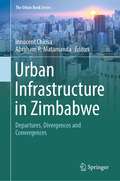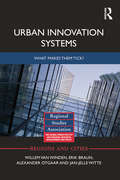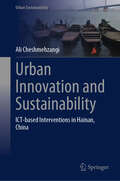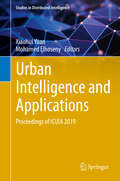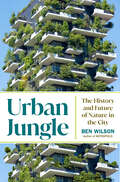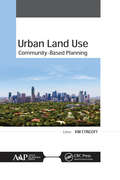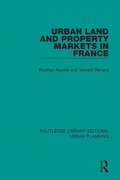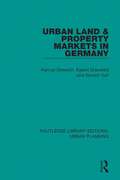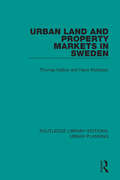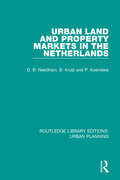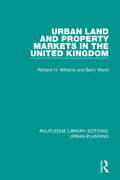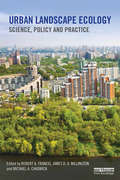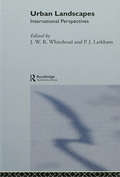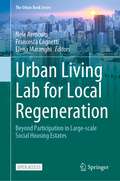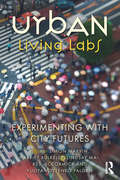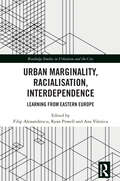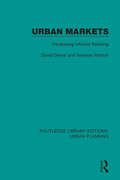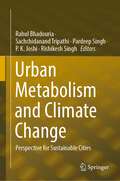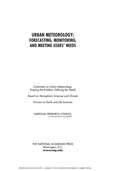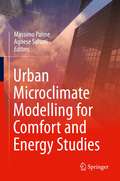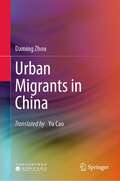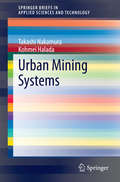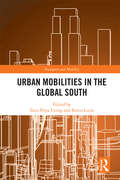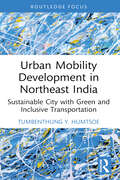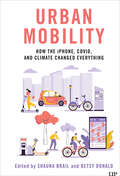- Table View
- List View
Urban Infrastructure in Zimbabwe: Departures, Divergences and Convergences (The Urban Book Series)
by Innocent Chirisa Abraham R. MatamandaThe book provides insights into urban infrastructure debates and discourses in Zimbabwe. Through an inter-disciplinary and multi-disciplinary approach, the book explores the theoretical, conceptual and lived experiences in urban infrastructure. The book focuses on case studies relating to urban transport, public housing, water and sanitation and Geographical Information Systems (GIS) among other substantive issues relating to urban infrastructure and services.
Urban Innovation Systems: What makes them tick? (Regions and Cities #72)
by Erik Braun Willem van Winden Alexander Otgaar Jan-Jelle WitteWhy are some regions and cities so good at attracting talented people, creating high-level knowledge, and producing exciting new ideas and innovations? What are the ingredients of success? Can innovative cities be created and stimulated, or do they just flourish by mere chance? This book analyses the development and management of innovation systems in cities, in order to provide a better understanding of what makes such systems perform. The book opens by developing a conceptual model that combines insights from urban economics with economic geography, urban governance and place marketing. This highlights the relevance of path dependence, different types of proximity (and the role of clusters, networks and platforms), institutional conditions, place attractiveness and place identity in the evolution of local innovation systems. The authors then draw on this conceptual framework to structure empirical case studies in three cities with a relatively high innovation performance: Eindhoven (the Netherlands), Stockholm (Sweden) and Suzhou (China). Through these case studies they provide a detailed analysis of how successful innovation systems evolve and what makes them tick. Unique to this book is the linking of analysis to concrete policy and management responses. The book ends with a discussion on six themes in the development of successful urban innovation systems: firm-capabilities and leader firms, higher education and research, attractive environment, place branding, institutional environment and entrepreneurship. Each theme is examined fully, drawing lessons from the case studies, and from recent insights and other cases discussed in the literature. This title will be of interest to students, researchers and policymakers involved in regional innovation systems, knowledge locations and cluster development.
Urban Innovation and Sustainability: ICT-based Interventions in Hainan, China (Urban Sustainability)
by Ali CheshmehzangiThis book is a collection of context-specific ICT-based interventions to achieve sustainability from various perspectives or dimensions. The book is based on case study examples in the strategic context of Hainan, South China. Five ICT-based pilot studies were conducted, surveyed, and analysed in 2021 and 2022. The studies explore impacts on four main sustainability dimensions of environmental, social, economic, and institutional. Several ICT-based interventions are suggested to enhance environmental protection, promote health and support in elderly communities, augment social media for place promotion, create online opportunities for local markets, and help boost local tourism industries. Urban Innovation and Sustainability is an attempt to highlight the positive side of ICT-based interventions in cities and communities. We also need to note the negative side of ICTs, which are partly covered in the case study examples. However, this book focuses on case study pilot examples to promote the nexus between innovation and sustainability. It is essential to explore opportunities that could later be scaled up, transform practices, and help develop context-specific policies. In essence, paradigm shifts, infrastructural development, and human-centric development are necessary. This book&’s findings interest scholars/researchers, practitioners, and authorities in various disciplines of urbanism, urban/human geography, urban studies, planning, innovation, and sustainability.
Urban Intelligence and Applications: Proceedings of ICUIA 2019 (Studies in Distributed Intelligence)
by Mohamed Elhoseny Xiaohui YuanThis volume presents selected papers from the International Conference on Urban Intelligence and Applications (ICUIA), which took place on May 10-12, 2019 in Wuhan, China. The goal of the conference was to bring together researchers, industry leaders, policy makers, and administrators to discuss emerging technologies and their applications to advance the design and implementation of intelligent utilization and management of urban assets, and thus contributing to the autonomous, reliable, and efficient operation of modern, smart cities. The papers are collated to address major themes of urban sustainability, urban infrastructure and management, smart city applications, image and signal processing, natural language processing, and machine learning for monitoring and communications applications. The book will be of interest to researchers and industrial practitioners working on geospatial theories and tools, smart city applications, urban mobility and transportation, and community well-being and management.
Urban Jungle: The History and Future of Nature in the City
by Ben WilsonIn this exhilarating look at cities, past and future, Ben Wilson proposes that, in our world of rising seas and threatening weather, the natural world may prove the city's savior.Since the beginning of civilization, humans have built cities to wall nature out, then glorified it in beloved but quite artificial parks. In Urban Jungle Ben Wilson—the author of Metropolis, a seven-thousand-year history of cities that the Wall Street Journal called &“a towering achievement&”—looks to the fraught relationship between nature and the city for clues to how the planet can survive in an age of climate crisis.Whether it was the market farmers of Paris, Germans in medieval forest cities, or the Aztecs in the floating city of Tenochtitlan, pre-modern humans had an essential bond with nature. But when the day came that water was piped in and food flown from distant fields, that relationship was lost. Today, urban areas are the fastest-growing habitat on Earth and in Urban Jungle Ben Wilson finds that we are at last acknowledging that human engineering is not enough to protect us from extremes of weather. He takes us to places where efforts to rewild the city are under way: to Los Angeles, where the city&’s concrete river will run blue again, to New York City, where a bleak landfill will be a vast grassland preserve. The pinnacle of this strategy will be Amsterdam: a city that is its own ecosystem, that makes no waste and produces its own energy. In many cities, Wilson finds, nature is already thriving. Koalas are settling in Brisbane, wild boar may raid your picnic in Berlin. Green canopies, wildflowers, wildlife: the things that will help cities survive, he notes, also make people happy.Urban Jungle offers the pleasures of history—how backyard gardens spread exotic species all over the world, how war produces biodiversity—alongside a fantastic vision of the lush green cities of our future. Climate change, Ben Wilson believes, is only the latest chapter in the dramatic human story of nature and the city.
Urban Land Use: Community-Based Planning
by Kimberly EtingoffThis compendium volume, Urban Land Use: Community-Based Planning, covers a range of land use planning and community engagement issues. Part I explores the connections between land use decisions and consequences for urban residents, particularly in the areas of health and health equity. The chapters in Part II provide a closer look at community land use planning practice in several case studies. Part III offers several practical and innovative tools for integrating community decisions into land use planning.
Urban Land and Property Markets in France (Routledge Library Editions: Urban Planning #1)
by Rodrigo Acosta Vincent RenardOriginally published in 1994, Urban Land and Property Markets in the United Kingdom, adopts a perspective that encompasses the distinctive nature of the legal framework, land law, property market and procedures of Scotland, England and Wales. The book provides detailed accounts of the structure of property, planning and tax law governing urban land and property markets, registration procedures and transactions charges, market processes and how they all work in practice. The book is based on a report commissioned by the German Federal Government as part of a five-country study completed in 1991.
Urban Land and Property Markets in Germany (Routledge Library Editions: Urban Planning #9)
by H Dieterich Egbert Dransfeld Winrich VossOriginally published in 1993, Urban Land and Property Markets in Germany describes the complex network of regulations and practices governing the operation of the German markets. The book outlines the constitutional structure and framework of the social, economic and geographical context in which the markets operate. The main sections of the book address the legal structures of property, planning, and tax, the registration procedures and transaction charges, market processes, who does what, and what professional titles or other actors in the process to look out for. The book also looks at the development of land and property markets, as one of the most intractable problems faced by post-communist regimes of eastern Europe.
Urban Land and Property Markets in Sweden (Routledge Library Editions: Urban Planning #14)
by Thomas Kalbro Hans MattssonOriginally published in 1995, Land and Property Markets in Sweden looks at the growing demand for an understanding of the urban land and property markets in Sweden. The book offers detailed accounts of the policy, legislative, and regulatory frameworks of urban land and property markets in Sweden, explaining how the markets operate and interact with the planning systems. It also incorporates a review of the second-home market, which is particularly well developed in Sweden. Fully detailed case studies are included to illustrate land development issues and the processes of purchase and sale of properties.
Urban Land and Property Markets in The Netherlands (Routledge Library Editions: Urban Planning #17)
by Barrie Needham Patrick Koenders Bert KruijtOriginally published in 1993, Urban Land and Property Markets in the Netherlands provides a detailed explanation of how the land and property markets of the Netherlands work. This book describes the scene extensively and goes deeper to explain the situation in the Netherlands, with commercial real estate being regarded internationally as mature, and offering good safe investment prospects while other aspects of the land and property markets are unique to that country. The constitutional, economic and social contexts are described and current public policies are explained as they affect property development.
Urban Land and Property Markets in the United Kingdom (Routledge Library Editions: Urban Planning #23)
by Barry Wood Richard H. WilliamsOriginally published in 1994, Urban Land and Property Markets in the United Kingdom, adopts a perspective that encompasses the distinctive nature of the legal framework, land law, property market and procedures of Scotland, England and Wales. The book provides detailed accounts of the structure of property, planning and tax law governing urban land and property markets, registration procedures and transactions charges, market processes and how they all work in practice. The book is based on a report commissioned by the German Federal Government as part of a five-country study completed in 1991.
Urban Landscape Ecology: Science, policy and practice (Routledge Studies in Urban Ecology)
by Robert A. Francis Michael A. Chadwick James D.A. MillingtonThe growth of cities poses ever-increasing challenges for the natural environment on which they impact and depend, not only within their boundaries but also in surrounding peri-urban areas. Landscape ecology – the study of interactions across space and time between the structure and function of physical, biological and cultural components of landscapes – has a pivotal role to play in identifying sustainable solutions. This book brings together examples of research at the cutting edge of urban landscape ecology across multiple contexts that investigate the state, maintenance and restoration of healthy and functional natural environments across urban and peri-urban landscapes. An explicit focus is on urban landscapes in contrast to other books which have considered urban ecosystems and ecology without specific focus on spatial connections. It integrates research and perspectives from across academia, public and private practitioners of urban conservation, planning and design. It provides a much needed summary of current thinking on how urban landscapes can provide the foundation of sustained economic growth, prospering communities and personal well-being.
Urban Landscapes: International Perspectives (Institute Of British Geographers Special Publication)
by P. J. Larkham J. W. R. WhitehandTaking a multidisciplinary approach this addresses the academic and practical issues concerning the present and future of the built environment, arguing for its enlightened management in the future of our present-day environment.
Urban Living Lab for Local Regeneration: Beyond Participation in Large-scale Social Housing Estates (The Urban Book Series)
by Nele Aernouts Francesca Cognetti Elena MaranghiThis open access book provides an integrated overview of the challenges and resources of large-scale social housing estates in Europe and outlines possible interdisciplinary approaches and tools to promote their regeneration. It especially focuses on the tool of urban living labs, as promising in promoting new and more effective local governance and in including the different actors into the planning process. The book combines theory and practice, since it is the result of action-research conducted in different social housing estates all over Europe.Building on the results of the SoHoLab project (2017–2020), the book benefits from a multidisciplinary perspective, since the researchers involved belong to the fields of anthropology, urban planning, architecture, urban sociology. The project combined theoretical reflections with the installation and/or the consolidation of Urban Living Labs, run by universities, in large social housing estates in three European cities: Brussels, Milan and Paris.
Urban Living Labs: Experimenting with City Futures
by Simon Marvin, Harriet Bulkeley, Lindsay Mai, Kes McCormick and Yuliya Voytenko PalganAll cities face a pressing challenge – how can they provide economic prosperity and social cohesion while achieving environmental sustainability? In response, new collaborations are emerging in the form of urban living labs – sites devised to design, test and learn from social and technical innovation in real time. The aim of this volume is to examine, inform and advance the governance of sustainability transitions through urban living labs. Notably, urban living labs are proliferating rapidly across the globe as a means through which public and private actors are testing innovations in buildings, transport and energy systems. Yet despite the experimentation taking place on the ground, we lack systematic learning and international comparison across urban and national contexts about their impacts and effectiveness. We have limited knowledge on how good practice can be scaled up to achieve the transformative change required. This book brings together leading international researchers within a systematic comparative framework for evaluating the design, practices and processes of urban living labs to enable the comparative analysis of their potential and limits. It provides new insights into the governance of urban sustainability and how to improve the design and implementation of urban living labs in order to realise their potential.
Urban Marginality, Racialisation, Interdependence: Learning from Eastern Europe (Routledge Studies in Urbanism and the City)
by Ryan Powell Filip Alexandrescu Ana VilenicaThis timely and interdisciplinary book deals with urban marginality as a multi-faceted process of urban transformation that engenders a wide range of experiences world-wide.Through the application of new empirical material and novel theoretical syntheses that exceed conceptual binaries (East-West, North-South), the authors explore shifting contemporary experiences of marginality in various urban contexts in Eastern Europe (EE). The unique articulation between global processes – such as gentrification, financialization, racialization and spatialization – and the distinctive histories, contestations and dislocations that characterize EE cities calls for increasing scholarly attention. The volume explores new patterns and drivers of urban marginality and racialization, and at the same time connects these to wider problematics of “advanced capitalist” cities as well as to post-socialist and anti-colonial urbanisms. The fourteen chapters contribute to a more nuanced understanding of global urbanism that decentres dominant Anglophone conceptualisations. Contributions focus empirically and theoretically on Czechia, Estonia, Hungary, Kosovo, Latvia, Lithuania, Romania, Serbia and Ukraine.The volume is recommended for students and urban scholars in EE and beyond, but will also be of interest to activists involved in housing and urban justice as well as in broader struggles towards the anti-racist city.
Urban Markets: Developing Informal Retailing (Routledge Library Editions: Urban Planning #8)
by Vanessa Watson David DewarOriginally published in 1990, Urban Markets looks at how the informal sector of the economy should be encouraged to assist in the alleviation of problems of poverty and unemployment. Despite this rhetoric, few concrete, implementable ways have been developed. This book is concerned with one such potential strategy which the authors consider to be particularly effective: the creation of both built and open markets for very small retailers and wholesalers. Based on experience of observing such markets in several continents, the authors combine a discussion of the theoretical issues surrounding the creation of urban markets with practical hints of how to establish and run them.
Urban Metabolism and Climate Change: Perspective for Sustainable Cities
by P. K. Joshi Pardeep Singh Rishikesh Singh Rahul Bhadouria Sachchidanand TripathiThis book provides a basic understanding and state-of-the-art of urban metabolism. Urban centres are increasingly challenged by population increase and the resultant environmental concerns including the urban sprawl and climate change. Different patterns of urbanization contribute to the changing climate via. differences in their urban metabolism represented by energy and matter. Urban metabolic studies in terms of energy and material inflows, outflows, and stocks can be associated with traditional evaluation techniques to help assess the magnitude and potential effects of variety of environmental challenges the world is facing today. Urban centres are critical real time observatories that indicate the impact anthropogenic activities have on global biogeochemical cycles. Urban processes have significant and lasting impacts on the global carbon budget. The technological and infrastructural advancements have fuelled an increase in urban inputs and outputs of material and energy. Therefore, more sustainable approaches need to be adopted in changing scenarios for urban planning, particularly for sustainable resource utilization and better waste management practices. The book emphasises on the sustainability in urban metabolism, sustainable urban planning, ecosystem services, and disaster resilience to provide an interdisciplinary understanding of urban metabolism. The book also identifies an urgent need to develop new methodological approaches for real time and reliable evaluation of urban metabolism.
Urban Meteorology: Forecasting, Monitoring, and Meeting Users' Needs
by Committee on Urban Meteorology: Scoping the Problem Defining The NeedsAccording to the United Nations, three out of five people will be living in cities worldwide by the year 2030. The United States continues to experience urbanization with its vast urban corridors on the east and west coasts. Although urban weather is driven by large synoptic and meso-scale features, weather events unique to the urban environment arise from the characteristics of the typical urban setting, such as large areas covered by buildings of a variety of heights; paved streets and parking areas; means to supply electricity, natural gas, water, and raw materials; and generation of waste heat and materials. Urban Meteorology: Forecasting, Monitoring, and Meeting Users' Needs is based largely on the information provided at a Board on Atmospheric Sciences and Climate community workshop. This book describes the needs for end user communities, focusing in particular on needs that are not being met by current urban-level forecasting and monitoring. Urban Meteorology also describes current and emerging meteorological forecasting and monitoring capabilities that have had and will likely have the most impact on urban areas, some of which are not being utilized by the relevant end user communities. Urban Meteorology explains that users of urban meteorological information need high-quality information available in a wide variety of formats that foster its use and within time constraints set by users' decision processes. By advancing the science and technology related to urban meteorology with input from key end user communities, urban meteorologists can better meet the needs of diverse end users. To continue the advancement within the field of urban meteorology, there are both short-term needs-which might be addressed with small investments but promise large, quick returns-as well as future challenges that could require significant efforts and investments.
Urban Microclimate Modelling for Comfort and Energy Studies
by Massimo Palme Agnese SalvatiThis book discusses urban microclimate and heat-related risks in urban areas, brought on by the combination of global climate change effects and local modification of climate determined by extensive urbanization such as the ‘Urban heat island’ phenomenon. This matter is relevant to almost all urbanized areas in the world, where the increase of urban population and air temperature is expected to endanger both the overall health of the population and the energy supply for the functioning of urban systems. The book details the inter-relationship between urban morphology, microclimate and building energy performance and presents a multidisciplinary approach that brings together Urban Climatology, Engineering and Architectural knowledge to support the development of reliable models and tools for research and practice. This book is a useful tool for architects and building energy modelers, urban planners and geographers who need a practical guide to realize basic urban microclimate simulation for use in both academic research and planning practice.
Urban Migrants in China
by Daming ZhouThis book focuses on the background, migration, and settlement of new migrants in China. It also examines the status of their social networks, the role of urban society, social security, and future planning. Based on semi-structured interviews, the book analyzes these aspects of new urban migrants and argues that:- Intellectual migrants, with their strong educational background, are willing to engage in urbanization and have clear entry strategies.- Labor migrants find it is challenging for labor migrants to receive the same welfare as citizens and they are subject to significant segregation in urban societies due to existing policies and market economy conditions.- Operational migrants have stronger settlement and family-oriented tendencies compared to labor migrants.
Urban Mining Systems
by Takashi Nakamura Kohmei HaladaThis book focuses on the fundamental concept of and current endeavors in "urban mining" among those who are interested in both metal resources and ecology. Systems for recycling and reusing precious metals and rare-earth minerals contained in used and discarded electronics are introduced in this book. The target audience is not academic researchers in the resource management and ecology fields but, rather, citizens who are concerned about our future environment and want to do something for the future.
Urban Mobilities in the Global South (Transport and Mobility)
by Karen Lucas Tanu Priya UtengThe book considers urban mobilities and immobilities in the Global South through an exploration of the theoretical and methodological entry points that can be used to further the agenda of transport planning. Transport system improvements can (and do) have complex and unequal impacts on different sectors of society. Conventional approaches to analysing travel demand and transport system performance developed in the ‘Global North’ are typically ill-equipped to identify and understand the complexities and inequities in urban areas of the Global South. Using case studies from urban Africa and Asia, the book addresses the need to understand the ‘lived world’ of mobilities and use this knowledge to address issues that are central to our urban existence in the 21st century.
Urban Mobility Development in Northeast India: Sustainable City with Green and Inclusive Transportation (Routledge Contemporary South Asia Series)
by Tumbenthung Y. HumtsoeUrban Mobility Development in Northeast India theoretically and empirically explores the interrelationship between and among city, transportation, economic growth and environment to contribute towards engendering green urbanization for green growth.In a time of aggravating environmental crisis, the book recognizes the duality of contrasting impact of city and transport to economic development and environmental degradation. To serve as a guide for policy research, the book accessibly presents a contextual study blending qualitative as well as quantitative methodology in the context of a highland as well as a frontier capital city of the Northeastern Indian state of Nagaland, Kohima, towards creating a sustainable city with an inclusive and green mobility. The book underscores that management of urbanization and urban mobility challenges should go beyond supply side management and demand side management by democratizing policy making as well as considering efficiency, equity, welfare and practicality concerns and suchlike rationales.By traversing from abstraction to everyday life, from global context to frontier context and from macro level to micro level, the book makes significant theoretical as well as empirical contribution. The book will be of use to students, researchers, policy practitioners as well as general readers interested in Urban Studies, Transport Economics, Growth Economics, Development Studies, Environmental Studies and Asian Studies, especially in relation to highland and frontier regions in developing economies in general and Northeastern Region of India in particular.
Urban Mobility: How the iPhone, COVID, and Climate Changed Everything
by Shauna Brail Betsy DonaldUrban Mobility sheds light on mobility in twenty-first-century Canadian cities. The book explores the profound changes associated with technological innovation, pandemic-induced impacts on travel behaviour, and the urgent need for mobility to respond meaningfully to the climate crisis. Featuring contributions from leading Canadian and American scholars and researchers, this edited collection traverses disciplines including geography, engineering, management, policy studies, political science, and urban planning. Chapters illuminate novel research findings related to a variety of modes of mobility, including public transit, e-scooters, bike-sharing, ride-hailing, and autonomous vehicles. Contributors draw out the connections between urban challenges, technological change, societal need, and governance mechanisms. The collection demonstrates why the smart phone, COVID-19, and climate present a crucial lens through which we can understand the present and future of urban mobility. The way we move in cities has been disrupted and altered because of technological innovation, the lingering impacts of COVID-19, and efforts to reduce transport-related emissions. Urban Mobility concludes that the path forward requires good public policy from all levels of government, working in partnership with the private sector and non-profits to direct and address the best urban mobility framework for Canadian cities.
